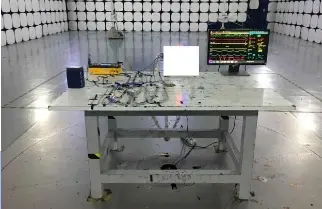
Automotive Electronics EMC Testing Laboratory
With the development of the times, technological advancements, and the improvement of people's quality of life, the demand for automobiles has been growing. At the same time, people have higher expectations for the overall comfort and safety of vehicles. The future of automobiles lies in electrification and intelligence, with more electronic products being integrated into cars, becoming an unstoppable trend. The electromagnetic compatibility (EMC) of these electronic components and the vehicle itself has a critical impact on the safety, reliability, and comfort of automobiles. Therefore, it is strictly regULated by governments and major automakers around the world. Automotive electronic products or vehicles that do not pass emc testing will not be favoRED by manufacturers or consumers.

Product Range:
- Body Electronics: External vehicle lights, optical signal devices, indirect vision devices, vehicle fans, battery BMS, switches, harness connectors, motors, dashcams, tire pressure monitoring systems, etc.
- Infotainment and Connectivity: T-Box, in-vehicle infotainment systems, navigation devices, central control displays, combination meters, streaming rearview mirrors, Bluetooth modules, HUD, car audio, in-vehicle refrigerators, etc.
- Safety and Comfort Systems: Air conditioning systems, seat adjustment systems, seat heating systems, electric horns, etc.
- Engine Electronic Systems: Engine management ECU, batteries, ignition systems, engine harnesses, etc.
- New Energy Vehicle Components: Electric motors and controls, on-board chargers, DC/DC converters, vehicle terminals, etc.
- Whole Vehicles: Civil passenger cars, SUVs, buses, forklifts, cranes, coaches, RVs, etc.
Testing Methods:
There are various testing methods for automotive electronic products internationally. When choosing a test method, parameters such as test frequency band, the test part of the EUT, interference source characteristics, and the size of the EUT should be considered to accurately assess the EUT’s immunity. Common EMS test methods include Bulk Current Injection (BCI), Free Field, Conducted Transient, and Electrostatic Discharge (ESD).
Test Items (Partial List):
- CTE Conducted Emission (Low Voltage Power 12/24V): ISO 7637-2
- CTE Conducted Emission (High Voltage Power 60-1500V): ISO 7637-4
- R1 BCI Bulk Current Injection: ISO 11452-4
- R1 Radiated Immunity: ISO 11452-2
- R1, C1 Conducted Immunity: ISO 7637-3
- Electrostatic: ISO 10605
- Immunity - Pulse A, Pulse B (High Voltage Power 60-1500V): ISO 7637-4
- Conducted Emission (CE): 9kHz-108MHz
- Radiated Emission (RE): 9kHz-5.8GHz
- Transient Conducted Emission: DC-1000V, 2GHz/s
- Low-Frequency Magnetic Field Interference testing (ME): 10Hz-200kHz
- Low-Frequency Electromagnetic Field Emission Testing: 9kHz-30MHz
- Bulk Current Injection (BCI): 10kHz-400MHz, Level: 200mA
- Anechoic Chamber Radiated Immunity (RI): 80MHz-3.2GHz, Level: 200V/m
- Electrostatic Discharge Immunity (ESD): ±30kV
- Handheld Transmitter Radiated Immunity: 26MHz-6GHz, 20W
- Pulsed Conducted Interference: ISO 7637-2, pulse 1-5
- Transient Conducted Interference: ISO 7637-3 CCC/DCC
- Low-Frequency Magnetic Field Immunity: 10Hz-250kHz, 180 dBuA/m
- Electrical Performance Testing: ISO 16750-2 Standard Items
- RE Radiation - Components: CISPR 25, E-Mark ECE R10, EN 50498
- RE Radiation - Vehicles: EN 15194, EN 12895
- CE Conducted Emission: CISPR 25, EN 50498
Automotive Electronics Reliability:
Tests include DC power voltage testing, overvoltage, superimposed AC voltage, slow ramping of power voltage, power voltage interruption, voltage dips, resets, startup testing, load dump testing, reverse voltage, short circuit protection, ground potential drift testing, etc. Capability Range: GB 28046.2, ISO 16750-2
Equipped with dual Boresight antenna towers, the main supporting equipment is imported, with absorbing foam from AEMI (USA) and ferrite from SAMWHA (Korea), along with the latest R&S receivers and Schwarzbeck antennas.
China’s JJR Laboratory has the largest 10-meter semi-anechoic chamber in China: 23.5*14.5*9 meters, with a maximum test turntable diameter of 6 meters and a load capacity of 8000kg.
Site Features: Dual antenna setup, effectively saving testing time.
Frequency Range: 9kHz—26.5GHz.
The laboratory is equipped with NF amplifier power supply 30KW, with both radiation and conduction tests equipped with 200A AC/DC power supplies.
Email:hello@jjrlab.com
Write your message here and send it to us
 What Certifications for Exporting Monitors to Euro
What Certifications for Exporting Monitors to Euro
 Bluetooth Headphones Exported to Australia Certifi
Bluetooth Headphones Exported to Australia Certifi
 What Certifications for Router Products Exported t
What Certifications for Router Products Exported t
 TIC (Power Bank UL 2056, Portable Power Station UL
TIC (Power Bank UL 2056, Portable Power Station UL
 How to get EN 18031 Certification for Wireless Pro
How to get EN 18031 Certification for Wireless Pro
 PSE, TELEC and VCCI Compliance for Cameras Exporte
PSE, TELEC and VCCI Compliance for Cameras Exporte
 NOM & IFT Compliance for Audio Equipment Expor
NOM & IFT Compliance for Audio Equipment Expor
 FCC, CE & EMC Compliance for Printers Exported
FCC, CE & EMC Compliance for Printers Exported
Leave us a message
24-hour online customer service at any time to respond, so that you worry!




